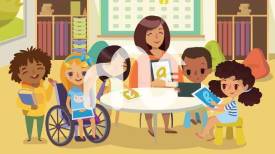15 Best Teaching Strategies to Boost Learning
If you wonder list of instructional strategies for teaching, you are in the right place. Classroom teaching strategies are educational techniques to foster effective learning. The best teaching strategies are thoughtfully designed to empower students. Let’s learn them together!
Powerful Online Teaching Strategies
Online teaching strategies have become paramount for engaging students in the virtual classroom. These innovative solutions enhance learning outcomes.
1. MentalUP Educational Platform
MentalUP is an award-winning learning app that leverages AI in gamification to make learning fun and effective. It offers 150+ brain games designed to boost cognitive skills, memory, and problem-solving abilities in students of all ages.

MentalUP isn't limited to nurturing children's minds; it also focuses on their physical well-being. In addition, MentalUP’s fitness module features 240+ personalized exercises in balance, strength, stretching, coordination, and endurance categories.
MentalUP stands as the world's first app combining the best effective teaching strategies for physical and cognitive development. Moreover, MentalUP has no ads and offers screen time-limiting features to minimize children's exposure to addictive technology.
What sets MentalUP apart is its ability to make learning enjoyable, turning education into a fun and engaging experience. 🎓
MentalUP is compatible with any device. You can seamlessly integrate core teaching strategies into various learning environments, ensuring that students not only excel academically but also foster a genuine love for learning. 📚
So, why wait? It is time to expand kids' potential! 🚀
2. Flipped Classroom Method
The flipped classroom method represents a pedagogical shift from the traditional learning structure. In this approach, students are tasked with engaging in instructional strategies for teaching-based content, such as video lectures or readings, at home before attending a physical class.

These teaching instructional strategies aim to optimize the use of classroom time, making it more interactive and engaging. One of the primary reasons why the flipped classroom method is highly regarded in education is its emphasis on active learning.
By moving passive content consumption outside the classroom, students are encouraged to take charge of their learning, enhancing their participation and involvement in the educational process.
Furthermore, the flipped classroom enables individualized learning. Students can progress through the material at their own pace, revisiting content when necessary. This flexibility accommodates diverse learning styles and abilities, promoting a more inclusive educational experience.
3. Synchronous and Asynchronous Learning
Balancing synchronous (real-time) and asynchronous (self-paced) learning activities accommodates diverse student schedules and preferences. While synchronous sessions allow for immediate interaction, asynchronous resources provide flexibility and self-guided exploration of course materials.

Synchronous and asynchronous learning are two inclusive teaching strategies employed in modern education. Synchronous learning involves real-time interactions, such as live lectures and webinars, facilitating immediate feedback and active discussions.
In contrast, asynchronous learning allows students to access course materials at their own pace, offering flexibility and self-guided exploration. The efficacy of these strategies lies in their capacity to meet the diverse needs of learners.
Balancing both approaches ensures the benefits of real-time engagement and immediate feedback, along with the flexibility and autonomy essential for accommodating various schedules and learning styles, making it a highly effective teaching strategy.
4. Personalized Learning Paths
Tailoring educational content to individual student needs through adaptive learning platforms and assessments helps students progress at their own pace. Personalized learning paths improve retention and understanding by addressing each student's unique strengths and weaknesses according to their types of learning styles.

This is often achieved through the use of adaptive learning platforms and assessments, providing students with a unique and customized learning experience. One of the key reasons personalized learning paths are considered one of the best types of teaching strategies is their ability to allow students to progress at their own pace, offering flexibility in the learning process.
By addressing each student's specific strengths and weaknesses, this approach enhances retention and understanding. It empowers learners to take control of their education, resulting in a more effective and engaging learning journey.
This approach acknowledges the uniqueness of each learner and harnesses it as a strength, ultimately leading to improved educational outcomes. So, it is one of the best dyslexia teaching strategies for dyslexic kids.
5. Collaborative Online Projects
If you are thinking about what strategies in teaching encourage collaboration, you can try assigning group work to kids that requires them to work together remotely. Tools like virtual whiteboards or the best apps for teachers, foster teamwork and communication skills, preparing students for future collaborative endeavors.

Collaborative online projects involve the assignment of group tasks that necessitate students to work together, even when physically separated. This teaching strategy stands out as one of the best due to its ability to encourage collaboration in a digital realm.
It offers students the opportunity to hone essential communication skills and develop effective teamwork. By leveraging classroom management tools such as virtual whiteboards and project management software, students engage in collaborative problem-solving, thereby fostering critical thinking and equipping them for future collaborative ventures, both within their educational journeys and future careers.
The Most Effective Teaching Strategies
In the quest for effective teaching strategies, educators have a vast array of options. By exploring evidence-based teaching techniques, instructors can create effective and engaging learning environments.
6. Differentiated Instruction
Tailoring teaching methods and strategies to individual students' needs allows for personalized learning, promoting better comprehension and engagement. Also, by addressing students' specific learning needs, differentiated instruction can lead to improved academic performance.

This versatile approach accommodates students with diverse learning styles, such as those with autism or dyslexia, ensuring that every learner's unique requirements are met. This is why differentiated instruction is one of the best teaching strategies for autism.
By addressing each student's specific strengths and areas of improvement, educators can create a supportive and inclusive learning environment that encourages students to obtain academic success and fosters a sense of self-efficacy.
Discover how different teaching strategies boost kids’ learning with MentalUP! This way, you can use the most effective teaching strategies in a user-friendly platform. 😇
MentalUP's fun activities cater to diverse learning styles for better outcomes. From toddlers to high schoolers, it provides a personalized learning experience tailored to kids' ages. 🏆
The app provides a personalized daily brain exercise plan that takes just 20 minutes, while MentalUP Fitness offers a daily exercise regimen that can be completed in a mere 7 minutes, infusing children with newfound energy and vitality. 🎵🏀
7. Peer Teaching
Peer teaching is a powerful pedagogical approach that involves students taking on the role of educators themselves, and sharing their knowledge with their peers. This strategy not only reinforces their understanding of the material but also empowers them to develop essential teaching and leadership skills.

By teaching their classmates, students become active participants in the learning process, fostering a deeper comprehension of the subject matter. Peer teaching has the unique advantage of promoting a sense of responsibility and collaboration among students.
It encourages students to think critically, communicate effectively, and empathize with their peers, as they adapt their teaching methods to suit the needs of different learners. It’s one of the best options if you’re seeking pedagogical strategies for teaching.
8. Active Learning
Incorporating hands-on activities and interactive exercises helps students absorb and retain information more effectively. This strategy is particularly effective for teaching comprehension strategies and engaging students in the classroom.

Active learning is a dynamic teaching strategy that emphasizes student participation and engagement in the learning process. It involves incorporating hands-on activities, discussions, and interactive exercises to help students absorb and retain information more effectively.
Active learning stands out as one of the best teaching strategies for several reasons. First and foremost, it recognizes the importance of students' active involvement in their learning.
9. Technology Integration
Harnessing the power of technology, such as online teaching strategies and educational apps, can enhance the learning experience and engage tech-savvy learners. It is ideal for innovative teaching strategies and is essential for teaching in the digital age.

The integration of technology is a pivotal component of modern education, and it plays a vital role in some of the best teaching strategies. Harnessing the power of technology, including online teaching strategies, EdTech tools for teachers, and educational apps, has become increasingly important in today's classrooms.
This approach is instrumental in enhancing the learning experience and engaging tech-savvy learners, making it an ideal choice for innovative teaching strategies and essential for teaching in the digital age. Technology integration is valuable for several reasons.
10. Scaffolded Instruction
Breaking down complex topics into manageable steps and gradually removing support helps students build their knowledge and skills systematically. This approach is valuable for guiding students through the learning process and employs research based teaching strategies.

These strategies represent just a few examples of the many teaching methods and strategies available to educators. By selecting the most suitable approaches for their unique teaching situations, instructors can create dynamic and inclusive classrooms that cater to the diverse needs of their students.
Engaging Classroom Teaching Strategies
In this section, we'll explore five of the best teaching strategies that foster student engagement and enhance the learning experience. These strategies are essential for creating a dynamic and participatory classroom environment:
11. Jigsaw Classroom
The Jigsaw Classroom is a cooperative learning strategy that encourages active participation and collaborative problem-solving. In this approach, students are divided into small groups, and each group becomes an expert on a specific topic or section of the material.

They study and understand that content in depth. Then, they regroup with students from other "expert" groups, sharing their knowledge and teaching each other. This method not only promotes in-depth understanding but also fosters teamwork and peer teaching.
The Jigsaw Classroom is an excellent way to engage students actively in the learning process and encourage them to work together to master a comprehensive body of knowledge.
This strategy can be particularly effective in subjects that require students to analyze and synthesize complex information, and it's adaptable to a wide range of age groups and subjects. It’s one of the best creative teaching strategies in the classroom.
Did you know that online learning platforms like MentalUP aren't just about having fun? They are also a fantastic tool for the classroom! 🎮
Want to make learning more engaging and effective? Look no further! The certified app MentalUP is the secret ingredient for an educational party in your classroom with cognitive development games improving kids' concentration, attention, and more! 🔥
Ready to incorporate innovative teaching strategies into your classroom? Start using MentalUP now! ✅
12. Storytelling
Storytelling is a timeless and captivating teaching strategy that transcends age and subject matter. It involves incorporating narratives, anecdotes, and real-life stories into lessons to make the content more relatable and engaging.

By weaving storytelling into the curriculum, educators can help students connect with the subject matter on a personal level. This not only adds an element of entertainment but also aids in retention and comprehension.
Stories have the power to create an emotional connection with the material, making it more memorable and impactful for students, whether it's explaining complex math concepts or historical events.
13. Game-Based Learning
Game-Based Learning is an innovative teaching strategy that leverages the principles of games and interactive challenges to make learning fun and engaging. Educational brain games and gamified elements are used to motivate students to participate actively and enjoy the learning process.

By incorporating elements like competition, rewards, and interactive challenges, educators can create a dynamic learning environment that fosters enthusiasm and exploration.
This approach is particularly effective in engaging students, whether it's teaching vocabulary strategies, math teaching strategies, art concepts, or other subjects, and can be adapted for various age groups.
14. Debate and Discussion
Debate and Discussion are powerful strategies for encouraging critical thinking, argumentation, and active participation in the classroom. These methods involve organizing debates, group discussions, and Socratic seminars, allowing students to voice their opinions and engage in thoughtful discourse.

By facilitating these exchanges, educators promote active involvement and challenge students to think critically about a subject.
This strategy not only strengthens students' communication skills but also enhances their ability to analyze and evaluate information from different perspectives, making it invaluable for subjects that require critical analysis and debate.
15. Service Learning
Engage students in community service or projects that apply academic learning to real-world issues, promoting civic engagement and active learning. Service Learning is an experiential teaching strategy that combines academic learning with community service or projects addressing real-world issues.

This approach engages students in hands-on, practical experiences that apply what they have learned in the classroom to benefit the community. It encourages civic engagement, active participation, and a deeper understanding of how academic knowledge can be applied to solve real-world problems.
Service Learning is not only an excellent way to promote active learning but also fosters a sense of social responsibility and empathy in students, making it a valuable strategy for educators interested in academic, character, and professional development.
Teaching Strategies Examples
In the realm of teaching, the effective application of teaching strategies plays a pivotal role in shaping successful learning experiences. These examples of teaching strategies not only facilitate the dissemination of information but also engage students, fostering a deeper understanding of the subject matter.

Culturally Responsive Teaching Strategies
Responsive teaching encourages students to feel that their identities are valued and respected. It recognizes the importance of not only what is taught but also how it is taught.
For example, when teaching vocabulary, instructors can select words and examples that resonate with the cultural experiences of their students, making the learning process more relatable and engaging.
Core Teaching Strategies
Core teaching strategies are the foundation upon which many other methods are built. These are the fundamental techniques that have consistently proven effective in fostering student engagement and understanding.
Vocabulary teaching strategies
Differentiated teaching strategies represent a vital aspect of any educator's role, and these strategies often form the building blocks of successful learning.
Vocabulary teaching strategies focus on enhancing students' word knowledge and language comprehension. By employing techniques such as word maps, context clues, and interactive brain words games, educators can make the process of language acquisition not only effective but also enjoyable.
Similarly, teaching reading strategies offer students the tools they need to comprehend and analyze text effectively. Techniques like questioning, predicting, and summarizing can help students become more active readers and critical thinkers.
Benefits of Teaching Methods and Strategies
As we explore the realm of education, let's zoom in on a crucial aspect: the Benefits of Teaching Methods and Strategies. In this section, we'll uncover the advantages these pedagogical tools offer, shedding light on the transformation they bring to the learning landscape.
- Enhanced Learning Outcomes: Effective teaching methods and strategies can significantly improve student comprehension, retention, and overall academic performance.
- Catering to Diverse Learning Styles: Different strategies allow educators to address various learning preferences, ensuring that every student can engage with the material in a way that suits them.
- Increased Student Engagement: Engaging teaching methods make learning more enjoyable, fostering a love for learning and reducing the risk of disengagement or dropout. Teachers can appreciate the engagement level of students through their report card comments.
- Better Student-Teacher Relationships: Implementing varied strategies can enhance the teacher-student connection, as educators can adapt their approach to meet individual needs.
- Improved Critical Thinking Skills: Certain teaching methods encourage students to think critically, problem-solve, and apply their knowledge in real-world situations.
- Promotion of Creativity: Strategies like project-based learning can stimulate creativity and innovation, allowing students to explore and express themselves.
- Adaptation to Age and Development: Tailoring teaching methods to different age groups ensures age-appropriate content and pedagogy, which can boost learning effectiveness.
- Efficient Time Management: The right classroom management strategies can help educators optimize their classroom time and ensure that key learning objectives are met.
Ready to witness developing students’ success? If the answer is yes, it is time to use MentalUP now! 👏
MentalUP enhances kids' physical and cognitive development. It also offers detailed reporting tools and performance-tracking features to help parents or teachers track their kids' development and understand their learning styles. 👪
Accelerate your child's educational journey with the best engaging teaching strategies of MentalUP now! 🎉





